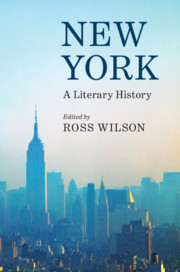
-
Select format
-
- Publisher:
- Cambridge University Press
- Publication date:
- February 2020
- February 2020
- ISBN:
- 9781108557139
- 9781108470810
- Dimensions:
- (228 x 152 mm)
- Weight & Pages:
- 0.6kg, 332 Pages
- Dimensions:
- Weight & Pages:
- Subjects:
- Literature, Area Studies, American Literature, American Studies
You may already have access via personal or institutional login- Subjects:
- Literature, Area Studies, American Literature, American Studies
Book description
New York City's streets, parks, museums, architecture, and its people appear in an array of literary works published from New York's earliest settlement to the present day. The exploration of the city as both a symbol and as a reality has formed the basis of New York's literature. Using the themes of adaptation, innovation, identity, and hope, this history explores novels, poetry, periodicals, and newspapers to examine how New York's literature can be understood through the notion of movement. From the periodicals of the nineteenth century, the Arabic writers of the city in the early twentieth century, the literature of homelessness, childhood, and the spaces of tragedy and resilience within the metropolis, this diverse assessment opens up new areas of research within urban literature. It provides an innovative examination of how writing has shaped the lives of New Yorkers and how writing about the city has shaped the modern world.
Reviews
‘The collection is too eclectic and wide-ranging to serve as a reference resource, but all the essays are thoughtful, well written, and provocative. The study of literature through the lens of space and place is a significant critical trend, one to which this book is an important contribution … Highly recommended.’
J. W. Miller Source: Choice
Contents
Metrics
Altmetric attention score
Full text views
Full text views help Loading metrics...
Loading metrics...
* Views captured on Cambridge Core between #date#. This data will be updated every 24 hours.
Usage data cannot currently be displayed.
Accessibility standard: Unknown
Why this information is here
This section outlines the accessibility features of this content - including support for screen readers, full keyboard navigation and high-contrast display options. This may not be relevant for you.
Accessibility Information
Accessibility compliance for the PDF of this book is currently unknown and may be updated in the future.


